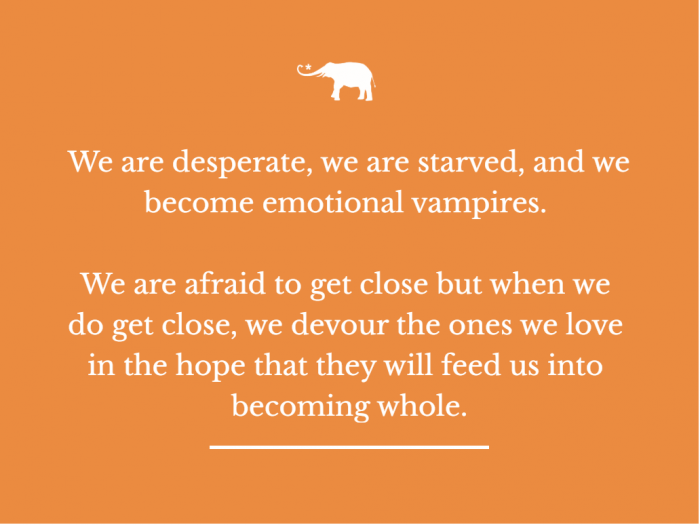View this post on Instagram
The worst feeling in the world is to sit in our own panic.
It is a feeling where our heart beats out of our chest and we feel the surge of anxiety run through every cell in our body. It is the feeling of dread that we are going to be left alone, left vulnerable, and possibly destroyed. Completely and utterly annihilated. We panic because it defies logic, and we cannot settle our increasing levels of anxiety.
The fear of abandonment is the belief that those close to us will leave us and we will be left alone with these dreadful feelings that could threaten to harm us.
The fear of abandonment is not a disorder in and of itself. It is what we all experience in relationships, especially intimate ones. However, when it is in its severe form, it is part of other disorders such and Borderline Personality Disorder, Avoidant Personality Disorder, Separation Anxiety Disorder, Attachment Disorders, Anxiety, Depression, and Complex Post Traumatic Stress Disorder.
The fear of abandonment for most adults who present with it feels primitive. It feels old because it was first experienced during our tender years under the age of three. A time when we had no words or limited words to describe our feelings. It was a time that we simply held it all in our vulnerable bodies. We held a feeling of dread that the ones we needed to care for us would not be there to soothe us. The ones we needed the most have abandoned us.
As adults, it seems that the close relationships we currently have, especially romantic ones, seem to trigger these feelings of anxiety. When we cannot resolve the fear of abandonment, we are left as adults crippled by this form of relational anxiety. We engage in behaviors that increase our feelings of craziness and shame. We are starved and afraid that whatever love we have will disappear and so we get desperate to keep the supply of love steadily available.
Unfortunately, these behaviors also recreate our abandonment because others feel drained and unable to soothe us with their imperfect love. This intensifies feelings of insecurity and unlovability.
Neuroscience gives the evidence we now have that our significant caregiver’s response to our attachment-seeking behavior wires us for the future. We do not need perfect parents or even two parents. We need at least one available, attuned, nurturing parent to meet our needs. It is good enough parenting.
All of this happens under the age of three when the primitive centers of our brain are in full force. The amygdala, which is the threat/fear radar, is tuning into our body’s internal processes and the external threats in the environment. We were born with a built-in survival response.
When we are young and experience an unpredictable and abandoning caregiver, the pain centers of our brain are activated. Emotional anguish feels the exact same as physical pain. In some of us, our emotional pain takes its form in our physical pain. When there is repeated unpredictability and unavailability, the amygdala becomes hypersensitive and activated.
We have no loving caregiver to soothe us. Our amygdala screams danger. We think we are going to die. Our survival brain goes into overdrive and we have only three options: fight, flight, freeze (feign death). Normal adult relationships have spaces between contact and times of uncertainty, but for some, real or imagined fear of abandonment signals threat.
This is the life of those crippled by the early impact of the fear of abandonment. Those unable to hold in mind the presence of a loving, available caregiver. The basic needs for safety, stability, security, love, reliability with at least one caregiver, is unmet. There is nobody to support us as we grow up and move from dependency to being independent. The message is that the world is not safe. Every move toward independence after the age of three has been filled with anxiety that to grow up will end in our annihilation. No wonder we move toward dependency in our relationships.
If we had a safe and predictable caregiver, we “hold” that parent in mind, even when separated from them. This is called object permanency, and it happens by the age of between two to three. We can tolerate separation knowing that we carry a loving parent internally that will soothe our fears even when we are separated from them. This parent is imperfect but good enough. Instead, those of us who have no mental image of a safe caregiver live in a constant state of survival responses.
We:
Freeze: We accept the belief that others will abandon us, and we choose abandoning, unavailable, and unpredictable partners. These relationships resemble our early ones. They might love us but are simply not there for us or they are cold and distant. The emotionally unavailable become our familiar spaces. We are passive, we are pleasing, and we accept our lot of emptiness and never assert our needs. In fact, we deny our own needs.
Flight: We avoid anything that triggers this belief and feelings. So, we avoid contact with places, people, or situations that trigger the fear of abandonment. We become the lone vampire who does not get close to others. We avoid intimate relationships to avoid experiencing the feelings associated with being abandoned.
When we are in a relationship, we avoid developing that closeness because it triggers anxiety. We are emotionally unavailable. When we break up or end relationships, we get over it quickly and resume our lone life. We develop a false sense of independence and self-sufficiency, the belief that we do not need others to meet our needs. In some cultures, this is enabled and greatly supported. The push for independence is valued but the disconnection is great.
Fight: We overcompensate when the feelings of abandonment are triggered. We push others away with clinging, possessive, or controlling behaviors. Many might constantly need reassurance and the presence of their partners or significant others. Some get consumed by irrational jealousy that can result in attempts to control the other. We desperately attempt to prevent abandonment. We fight against it. Those who have more antisocial traits—they threaten, stalk, harass and endanger those that threaten to abandon them.
We are emotional vampires, dripping with hunger, feeling unlovable, so afraid to come close but also so starved and obsessed with keeping the other person hostage to our insatiable need to never be abandoned. We scream, “I love you, please don’t leave me.”
Even though the fear of abandonment is not a clinical diagnosis, it can certainly paralyse and consume how we live in the world but most of all how we relate to others. We only relate to others as responsible for easing our own emotional pain. We do not see others as individuals with their own needs for separateness, individuality, fallibility, and interconnectedness. We see them as the two-month-old that we still are. Completely helpless and dependent.
How can we fill the void within?
How can we address the three coping responses to the fear of abandonment that turn us into emotional vampires?
Through my own therapeutic processes and training in relational psychotherapy, I can only say this with certainty: “We may not have caused our deep traumatic wounds in early childhood, but we are responsible for our recovery.”
So, with this in mind:
1. Seek ongoing therapy to address the early relational wounds of an inconsistent and unpredictable caregiver. It is not a quick fix, and it will feel worse before it ever gets better.
2. If there are life-threatening behaviors that we engage in, then we need to engage in Dialectical Behavioral Therapy with the primary goal of reducing therapy interfering and life-threatening behaviors. We cannot engage in deep trauma work without safety and stability of personality.
3. Our inner child needs to grieve the lack of capacity of our caregivers to truly be there for us. Most of our caregivers never could give what they themselves did not receive. Some of our caregivers were struggling with domestic violence, mental illness, and addiction to be available.
4. Our adult, more resourceful selves need to attune to and love the child within. We should commit to never abandoning ourselves by practicing nurturing attuned acts of care for our inner child. We can soothe our fears. We can stop searching for the Caregiver we never had.
5. When we develop object permanency, we also learn that our loved ones will leave at times, but the secure bond will continue. They can be angry at us and still love us. At times they might need space away from us to refuel, but out of sight does not mean out of mind. We stop seeing others as all good and all bad. We understand that our partners and those significant to us can be good enough and fallible at the same time. We stop idealizing and then devaluing people when they fail to live up to our unrealistic expectations.
6. We do not, as adults, have any guarantees that another will be with us forever. Sometimes relationships end because we are mismatched. Sometimes they end because of death. We can never as adults be abandoned because we can take care of ourselves and we are not dependent and helpless as we were when we were little.
7. We can set limits and space and do not need to be loners avoiding love and affection and close relationships. We can come close without being engulfed because we can set healthy limits.
As I have worked through my own fears of abandonment and have accompanied others through theirs, I am deeply aware that it was not fair, and it was a cruel injustice to abandon a child emotionally, but as adults, we cannot continue the cycle of wounding ourselves.
We need not lose faith and hope that we can get better. That we can heal and feel whole, and we can honor the child within and offer them the connection they so deeply crave. We deserve to live our authentic lives, consistently connected within, and healthily connected to others, through all of life’s uncertainties.
~









Read 72 comments and reply